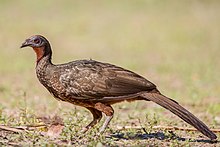
The black-backed grosbeak is a bird in the family Cardinalidae, the cardinals or cardinal grosbeaks. It is found in Argentina, Brazil, Bolivia, Colombia, Ecuador, Paraguay, Peru, and Venezuela. They are often kept as cagebirds.

The black-fronted piping guan or jacutinga in Brazilian Portuguese is a bird in the chachalaca, guan, and curassow family Cracidae. It is found in Argentina, Brazil, and Paraguay.

The sickle-winged guan is a species of bird in the chachalaca, guan, and curassow family Cracidae. It is found in Bolivia, Colombia, Ecuador, and Peru.

The black guan is a species of bird in the chachalaca, guan, and curassow family Cracidae. It is found in Costa Rica and Panama.

The crestless curassow is a species of bird in the family Cracidae, the chachalacas, guans, and curassows. It is found in Brazil, Colombia, Guyana, and Venezuela.

The Chaco chachalaca is a species of bird in the family Cracidae, the chachalacas, guans, and curassows. It is found in Argentina, Bolivia, Brazil, Paraguay, and possibly Uruguay.

Spix's guan is a species of bird in the family Cracidae. It is "the prototypical cracid of the Amazonian lowlands." The common name commemorates the German naturalist Johann Baptist von Spix (1782-1826).

The white-browed guan is a species of bird in the chachalaca, guan, and curassow family Cracidae. It is endemic to northeastern Brazil.

The Marail guan or Cayenne guan is a species of bird in the family Cracidae, the chachalacas, guans, and curassows. It is found in Brazil, French Guiana, Guyana, Suriname, and Venezuela.

The dusky-legged guan is a species of bird in the family Cracidae, the chachalacas, guans, and curassows. It is found in Uruguay, northeastern Argentina and southernmost areas of Paraguay and Brazil. In early 2021, the former subspecies P. o. bridgesi, found in southwestern Bolivia and northwestern Argentina, was elevated to species rank as Yungas guan.

The rusty-margined guan is a species of bird in the family Cracidae, which includes the chachalacas, guans, and curassows. It is found in Argentina, Bolivia, Brazil, and Paraguay.

The red-throated piping guan is a species of bird in the chachalaca, guan, and curassow family Cracidae. It is found in Bolivia and Brazil.

The Picui ground dove or Picui dove is a species of bird in the family Columbidae. It is found in Argentina, Bolivia, Brazil, Chile, Colombia, Paraguay, Peru, and Uruguay.

The Yungas dove, also known as the white-faced dove or large-tailed dove, is a species of bird in the family Columbidae. It is found in Argentina and Bolivia.

The Chaco sparrow, formerly known as the stripe-capped sparrow, is a species of bird in the family Passerellidae. It is found in Argentina and Paraguay.

The brown-backed mockingbird is a species of bird in the family Mimidae. It is found in Argentina and Bolivia.

The blue-crowned trogon is a species of bird in the family Trogonidae, the quetzals and trogons. It is found in Argentina, Bolivia, Brazil, Colombia, Ecuador, Paraguay, and Peru.

The East Brazilian chachalaca is a species of bird in the family Cracidae, the chachalacas, guans, and curassows. It is endemic to eastern Brazil.

The Yungas sparrow is a species of bird in the family Passerellidae endemic to the Yungas region of southeastern Bolivia and northwestern Argentina. It was formerly considered a subspecies of what was then called the stripe-capped sparrow.

The Yungas guan is a species of bird in the family Cracidae, the chachalacas, guans, and curassows. It is found in the Andean foothills of Argentina and Bolivia.























